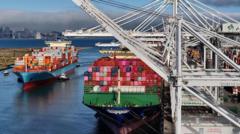Countries such as Laos and Myanmar face tariffs as high as 40%, while India is threatened with a potential increase to 50% unless it ceases purchasing oil from Russia. Notably, Trump has also announced a 100% tariff on imported computer chips, pressuring tech firms to invest more heavily within the U.S. Although these tariffs aim to strengthen the U.S. economy, they have raised concerns about potential adverse effects on the broader global market.
In recent months, uncertainty surrounding trade agreements led many countries to reach agreements with the U.S. to guarantee lower tariff rates. Meanwhile, stock markets in Asia have responded relatively positively to these developments, offering a semblance of stability after periods of turmoil. Key economies, including the UK and South Korea, found some respite with negotiated deals that soften the impact of Trump's tariffs.
However, the move also sparks international contention, particularly with nations like India, which voiced discontent over Trump's demands. Furthermore, the imposition of tariffs on goods imported from countries that continue to engage with Russia reflects an overarching strategy to influence foreign policy through economic means.
As Trump navigates a complex geopolitical landscape, his administration's approach to tariffs serves as a dual leverage tool—reinforcing domestic manufacturing while imposing broader economic pressures on nations engaged with adversarial regimes. With ongoing negotiations and potential economic fallout lingering, the full impact of these tariffs on both domestic and global economies remains to be seen.
In recent months, uncertainty surrounding trade agreements led many countries to reach agreements with the U.S. to guarantee lower tariff rates. Meanwhile, stock markets in Asia have responded relatively positively to these developments, offering a semblance of stability after periods of turmoil. Key economies, including the UK and South Korea, found some respite with negotiated deals that soften the impact of Trump's tariffs.
However, the move also sparks international contention, particularly with nations like India, which voiced discontent over Trump's demands. Furthermore, the imposition of tariffs on goods imported from countries that continue to engage with Russia reflects an overarching strategy to influence foreign policy through economic means.
As Trump navigates a complex geopolitical landscape, his administration's approach to tariffs serves as a dual leverage tool—reinforcing domestic manufacturing while imposing broader economic pressures on nations engaged with adversarial regimes. With ongoing negotiations and potential economic fallout lingering, the full impact of these tariffs on both domestic and global economies remains to be seen.




















